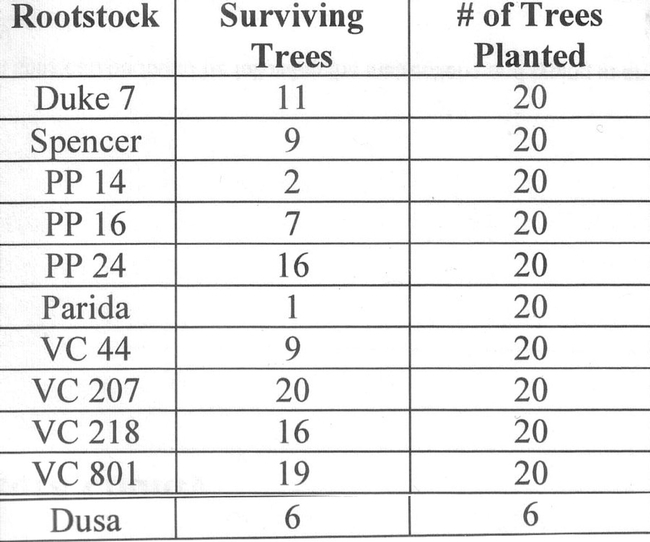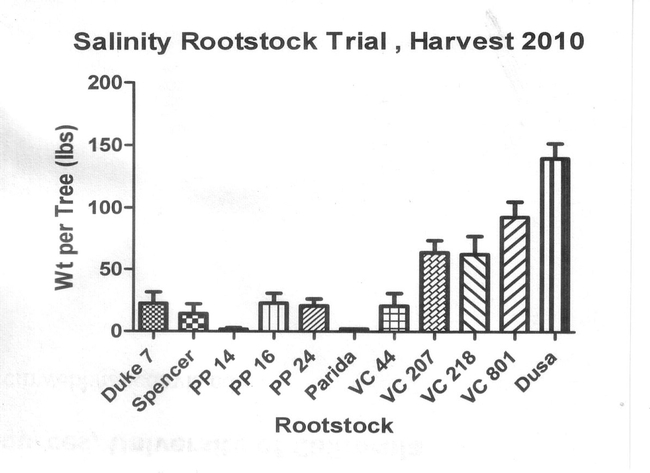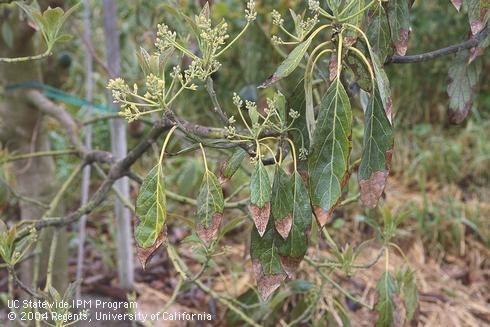This is the story of a remarkable avocado rootstock trial that was set up in 2004, lost to the freeze of January 2007, recovered (mostly) and had its first harvest in spring of 2010. But the real story is how some of the rootstocks bore at a really high rate with water that was so saline that almost killed most of our California rootstocks.
As part of Crowley and Arpaia's salinity rootstock trial, in cooperation with farm advisors and several growers, and funded by the California Avocado Commission, this particular trial was planted in 2004 at the Nick Stehly Ranch in Valley Center. The trial had 10 different rootstocks all grafted with Hass scions. Twenty trees of each rootstock were planted in a randomized and replicated block design: the rootstocks were Duke 7, Spencer, Parida, VC 44, VC 207,VC 801, VC 218, PP14 (Uzi), PP 16 (Rio Frio) and PP24 (Steddom). The VC series are rootstocks selected in Israel for tolerance to salinity, and the PP series are rootstocks selected for root rot tolerance by Dr. John Menge at the Plant Pathology Dept., U.C. Riverside. At the time of planting it was not known how the PP trees would react to salinity.
In Spring 2005 we planted six Hass/Dusa trees into vacant spots in the trial. These trees were left over from a Bender irrigation trial on another part of the ranch.
The trees were grown with highly saline irrigation water with an average EC of 2.5 and chloride levels of approximately 300 ppm. Needless to say, most of these trees suffered greatly with severe tip-burn and some of the trees almost died. But some looked better than others and we were waiting for the first harvest. In Spring 2006 some the trees set fruit and we expected the first harvest to be in 2007. But then disaster struck!
In January 2007 we had a serious freeze in San Diego County. Nick Stehly called us to let us know that he recorded a temperature of 18° F in our plot. All of the trees looked like they had died and we gave up on this plot and went on to other trials.
But the irrigators didn't give up! They kept pruning the dead wood out of the trees that did not die and gradually brought most of the trees back to life. But the trees were still being irrigated with the saline water, except for one important difference.
The Stehly family liked to swim in the reservoir about three times during each summer. So they would fill the small reservoir at the end of the ranch that supplied our trial, with Metropolitan Water District water with an EC of 0.7 – 0.9. After swimming they used this water for an irrigation of the trial. Amazingly, this “leaching” irrigation was apparently enough to keep the trees growing without too much tip-burn, and the irrigator reported to Nick in January, 2010 that we had enough fruit for a harvest.
The first harvest was completed in March,2010. The data for mean pounds of fruit per tree is presented in Figure 1. The number of surviving trees after the freeze of 2007 is presented in Table 1.


The mean wt of Hass avocados for the VC 801 rootstock was 92.2 lbs, and the mean wt for the Dusa rootstock was 139 lb. If this is compared to the San Diego County average yield of 7000 lbs per acre (about 70 lbs per tree), it would indicate that we might be making progress in finding some better rootstocks for use with some of our saline irrigation waters. However, as we all know, you can't base any conclusions on one year of yield data. We need to have at least three years of yield data to even begin to make a conclusion.
Our hats off to the irrigators at the Stehly Ranch, and to the Stehly family for their cooperation (and their reservoir/swimming pool). You never know what might show up in some of these older rootstock trials.
